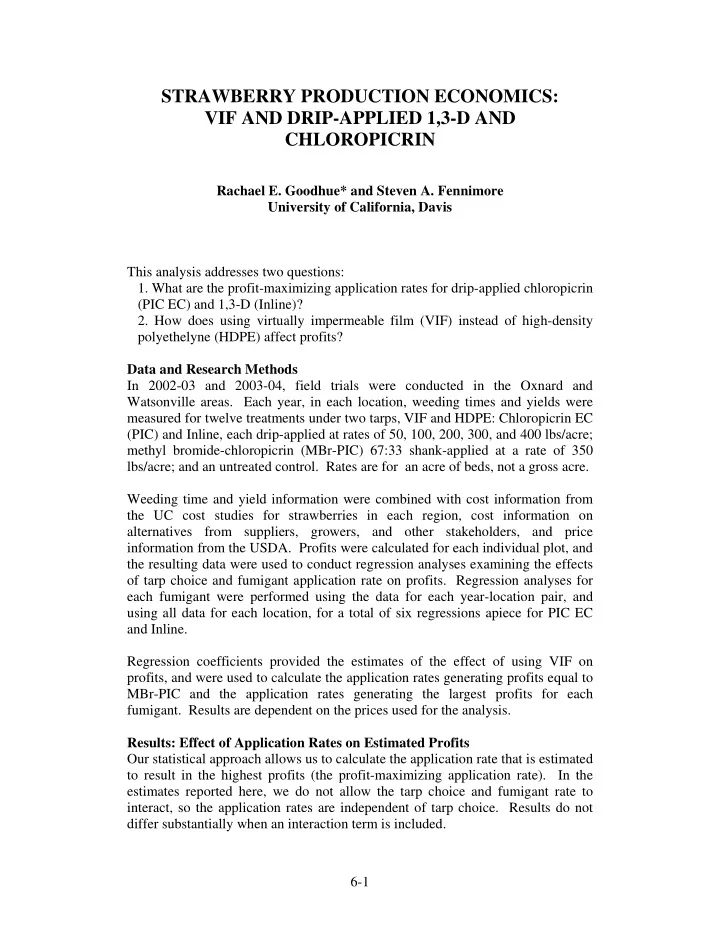

STRAWBERRY PRODUCTION ECONOMICS: VIF AND DRIP-APPLIED 1,3-D AND CHLOROPICRIN Rachael E. Goodhue* and Steven A. Fennimore University of California, Davis This analysis addresses two questions: 1. What are the profit-maximizing application rates for drip-applied chloropicrin (PIC EC) and 1,3-D (Inline)? 2. How does using virtually impermeable film (VIF) instead of high-density polyethelyne (HDPE) affect profits? Data and Research Methods In 2002-03 and 2003-04, field trials were conducted in the Oxnard and Watsonville areas. Each year, in each location, weeding times and yields were measured for twelve treatments under two tarps, VIF and HDPE: Chloropicrin EC (PIC) and Inline, each drip-applied at rates of 50, 100, 200, 300, and 400 lbs/acre; methyl bromide-chloropicrin (MBr-PIC) 67:33 shank-applied at a rate of 350 lbs/acre; and an untreated control. Rates are for an acre of beds, not a gross acre. Weeding time and yield information were combined with cost information from the UC cost studies for strawberries in each region, cost information on alternatives from suppliers, growers, and other stakeholders, and price information from the USDA. Profits were calculated for each individual plot, and the resulting data were used to conduct regression analyses examining the effects of tarp choice and fumigant application rate on profits. Regression analyses for each fumigant were performed using the data for each year-location pair, and using all data for each location, for a total of six regressions apiece for PIC EC and Inline. Regression coefficients provided the estimates of the effect of using VIF on profits, and were used to calculate the application rates generating profits equal to MBr-PIC and the application rates generating the largest profits for each fumigant. Results are dependent on the prices used for the analysis. Results: Effect of Application Rates on Estimated Profits Our statistical approach allows us to calculate the application rate that is estimated to result in the highest profits (the profit-maximizing application rate). In the estimates reported here, we do not allow the tarp choice and fumigant rate to interact, so the application rates are independent of tarp choice. Results do not differ substantially when an interaction term is included. 6-1
Oxnard. For Oxnard, the profit-maximizing application rate for chloropicrin is roughly 300 pounds per acre, with point estimates of 276, 292, and 217 pounds per acre (Table 1). The data are much less informative regarding the profit- maximizing application rate for Inline in Oxnard, and there is much less consistency across datasets. The 2003-2004 data generate an estimated profit- maximizing application rate that is larger than the largest experimental rate. There is a difference of 127 lbs/acre between the largest and the smallest estimates. Watsonville. For Watsonville, the profit-maximizing application rate for chloropicrin is roughly 260 pounds per acre, with individual estimates of 259, 260, and 267 (Table 2). The profit-maximizing application rate for Inline is approximately 370 pounds, with individual estimates of 354, 369, and 381. Results: Effect on Estimated Profits of Using VIF Overall, the results from the three datasets suggest that using VIF increases profits in the Oxnard area. VIF increased estimated profits for both fumigants in all three datasets. The data indicate that the estimates from the 2003-04 and combined datasets have high levels of statistical significance, which means that there is a very low chance that the actual value of using VIF is zero. The statistical analysis for Watsonville is much less clear. The 2002-03 data suggest that using VIF reduces profits, and that this reduction is statistically significant for Inline. The 2003-04 data suggest that using VIF increases profits, and that this increase is statistically significant for Inline. The combined data estimate a gain from using VIF for PIC EC, and a loss from using VIF with Inline, but neither effect is statistically significant. Table 3 reports these results. Advantages of Alternatives • Chloropicrin EC and Inline are profitable at commercially popular application rates. • Profit-maximizing application rates are within current regulatory limits. • .Under Oxnard conditions, using VIF increased profits relative to using HDPE for chloropicrin EC and Inline. • VIF reduces emissions from fumigants at a given application rate, which may affect use regulations. Disadvantages of Alternatives • It can be difficult to obtain a permit to apply chloropicrin alone near populated areas in some counties in California. • 1,3-D is subject to township limitations, which may limit availability in some areas in California. • Chloropicrin and 1,3-D are volatile organic compounds, which contribute to ground-level ozone. California’s efforts to reduce ozone levels may lead to regulations that decrease the profitability of these alternatives. 6-2
Table 1 Estimated profit-maximizing application rates (lbs/acre): Oxnard 2002-03 2003-04 Combined Data PIC 276 317 292 INLINE 282 419* 323 * Profit-maximizing point outside of data range Table 2 Estimated profit-maximizing application rates (lbs/acre): Watsonville 2002-03 2003-04 Combined Data PIC 259 267 260 INLINE 354 381 369 Table 3 Estimated gain from using VIF instead of HDPE at profit-maximizing application rate (Percent HDPE Profits ) Year 2002-03 2003-04 Combined data Oxnard Watsonville Oxnard Watsonville Oxnard Watsonville PIC 4.9% -3.7% 12.5%* 12.0% 10.1%** 6.7% INLINE 7.0% -19.1%** 15.2%** 13.8%** 12.9%*** -0.8% * Significant at the 10% level ** Significant at the 5% level *** Significant at the 1% level 6-3
Recommend
More recommend